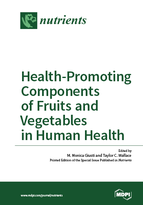Health-Promoting Components of Fruits and Vegetables in Human Health
A special issue of Nutrients (ISSN 2072-6643).
Deadline for manuscript submissions: closed (15 May 2016) | Viewed by 291163
Special Issue Editors
Interests: chemistry of polyphenols; anthocyanins; phytochemicals; analytical chemistry
Special Issues, Collections and Topics in MDPI journals
Interests: anthocyanins; dietary bioactives; multivitamins; dietary supplements; choline; eggs; calcium; vitamin D; bone health
Special Issues, Collections and Topics in MDPI journals
Special Issue Information
Dear Colleagues,
There is general agreement within the fields of food, nutrition, and medical sciences that an individual’s diet and lifestyle choices can substantially predispose one to, or protect against, many age- and obesity-related chronic diseases. The NIH Office of Dietary Supplements has defined dietary bioactives as “compounds that are constituents in foods and dietary supplements, other than those needed to meet basic human nutritional needs, which are responsible for changes in health status.”1 These compounds are generally thought to be safe in food at normal consumption levels (e.g., anthocyanins in berries). Their biological activities may be defined as a single compound (e.g., lutein in spinach) or class of compounds (e.g., avenanthramides in oats) for which optimal effects may be achieved through consumption of mixtures where the exact identity and composition is often unknown. Classes of similar compounds are commonly found in similar types of plants; however their incidence in the food can vary significantly because of environmental influences, such as cultivation, soil, altitude, and weather conditions. Substantial scientific evidence is available for some health promoting phytochemicals, including dose-response relations, and statistically significant relations with improved physiologic performance and/or reduction in the risk of chronic disease. However, several limitations relating to absorption, distribution, metabolism and excretion of many dietary bioactives still exist and must be better understood in the scientific literature. It is our hope that this Special Issue will attract manuscripts that advance our understanding of how dietary bioactive, particularly from fruits and vegetables, influence long-term health maintenance and disease prevention.
Dr. M. Monica Giusti and Dr. Taylor C. Wallace
Guest Editors
Manuscript Submission Information
Manuscripts should be submitted online at www.mdpi.com by registering and logging in to this website. Once you are registered, click here to go to the submission form. Manuscripts can be submitted until the deadline. All submissions that pass pre-check are peer-reviewed. Accepted papers will be published continuously in the journal (as soon as accepted) and will be listed together on the special issue website. Research articles, review articles as well as short communications are invited. For planned papers, a title and short abstract (about 100 words) can be sent to the Editorial Office for announcement on this website.
Submitted manuscripts should not have been published previously, nor be under consideration for publication elsewhere (except conference proceedings papers). All manuscripts are thoroughly refereed through a single-blind peer-review process. A guide for authors and other relevant information for submission of manuscripts is available on the Instructions for Authors page. Nutrients is an international peer-reviewed open access semimonthly journal published by MDPI.
Please visit the Instructions for Authors page before submitting a manuscript. The Article Processing Charge (APC) for publication in this open access journal is 2900 CHF (Swiss Francs). Submitted papers should be well formatted and use good English. Authors may use MDPI's English editing service prior to publication or during author revisions.
Keywords
- dietary bioactives
- health
- disease prevention
- functional foods
- nutrition
- fruits
- vegetables
- whole grains
- antioxidant
- non-essential nutrient
Benefits of Publishing in a Special Issue
- Ease of navigation: Grouping papers by topic helps scholars navigate broad scope journals more efficiently.
- Greater discoverability: Special Issues support the reach and impact of scientific research. Articles in Special Issues are more discoverable and cited more frequently.
- Expansion of research network: Special Issues facilitate connections among authors, fostering scientific collaborations.
- External promotion: Articles in Special Issues are often promoted through the journal's social media, increasing their visibility.
- Reprint: MDPI Books provides the opportunity to republish successful Special Issues in book format, both online and in print.
Further information on MDPI's Special Issue policies can be found here.








